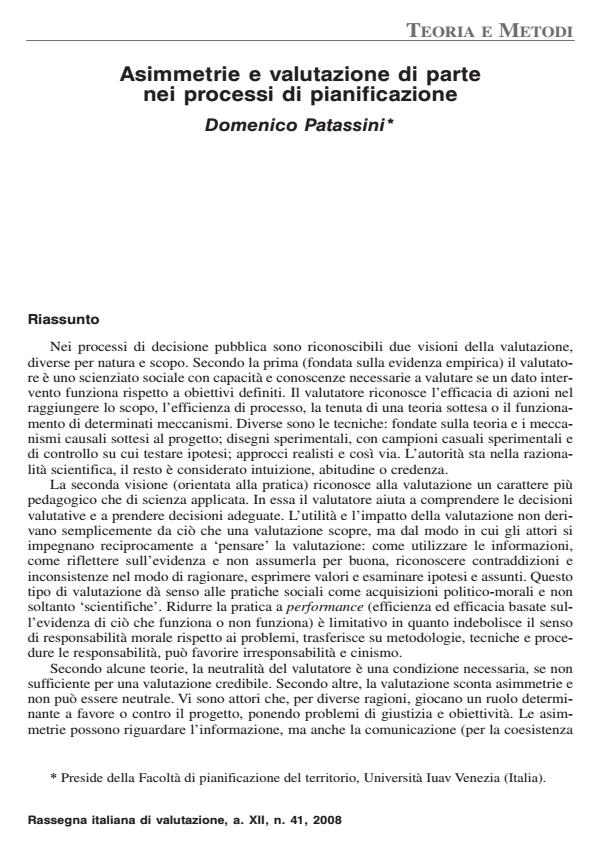Asimmetrie e valutazione di parte nei processi di pianificazione
Journal title RIV Rassegna Italiana di Valutazione
Author/s Domencio Patassini
Publishing Year 2009 Issue 2008/41
Language Italian Pages 22 P. 7-28 File size 620 KB
DOI 10.3280/RIV2008-041002
DOI is like a bar code for intellectual property: to have more infomation
click here
Below, you can see the article first page
If you want to buy this article in PDF format, you can do it, following the instructions to buy download credits

FrancoAngeli is member of Publishers International Linking Association, Inc (PILA), a not-for-profit association which run the CrossRef service enabling links to and from online scholarly content.
Asimmetrie e valutazione di parte nei processi di pianificazione - In public decision-making processes there can be two evaluation perspectives, each different in nature and role. The first one, the evidence-based perspective has an evaluator, a social scientist, with the required know-how which assesses if a specific action works in achieving particular goals. The evaluator must recognize the effectiveness of actions in reaching a particular goal, the efficiency of the process, the validity of a subtended theory, and whether certain mechanisms work. Different techniques can be applied. They include: the theory-driven technique which highlights the project theory and the subtended mechanisms; experimental procedures that test the project hypothesis; and realistic approaches and so forth. The authority stems entirely from scientific rationality, all the rest is viewed as intuition, customs or beliefs. The second, the practice-oriented perspective, confers a more pedagogic, rather than scientific, role to evaluation. Here, the evaluator contributes to help understand the assessment content, and to help make suitable decisions. The use and impact of evaluation comes not merely from the evaluation findings yield, but from the way its actors are reciprocally committed to ‘thinking out’ an evaluation. These include examining how: information is used; evidence is considered and not assumed to be right; contradictions and inconsistencies can arise from the reasoning process; values are expressed; theories and assumptions are assessed. This kind of evaluation attributes a sense to social practices making them not merely ‘scientific’ acquisitions, but also ethical ones. To stop at performance alone (evidence based efficiency and effectiveness) is limiting for it weakens the sense of moral responsibility in problem solving, and it transfers liability onto methodologies, techniques and procedures, often leading to irresponsibility and cynicism According to some theories, a premise of a credible evaluation is the evaluator’s neutrality. But according to other theories, every evaluation has asymmetries, hence such neutrality is not always desirable. There are actors, who for different reasons, play a fundamental role in favouring or hindering a project, posing justice and objectivity problems. Asymmetry can pertain to information, but also to communication (different codes), legitimation, power play, the project’s relation to the programme or plan, specific territorial planning strategies and the chance to access funds. In the judgment criteria, reducing such asymmetries to a ‘vector of weights’ seems unreasonable (and perhaps irresponsible). The evaluator must therefore highlight the way the information about the programme reflects the judgment value of various participants, especially the weaknesses. An evaluator can build tailored evaluations or become a sort of open advocate for social justice, for instance, defending, when needed, a programme’s positive results, ones that benefit the weak, or justifying why such programme must be rejected. The advocate-adversary evaluation, (or adversary approach), is conducted by two evaluators, (or two teams), who strive to prove, by being either for or against, a thesis, a hypothesis, options or results. Their stance can be judged by a either a jury or a judge, or both. Yet some doubt persists on whether this approach is better at representing an action, or whether it is unrealistic. Generally, to confer the same status to two opposing views can seem a neutral presentation: but it is not always so. The advocate team approach on the other hand, as preliminary evaluation, elaborates, in detail, the driving options of decisionmakers. This could also be true for weaker actors too. Advocacy evaluation (AE) practices evolve from such contexts and take on specific implications. Questions on the commission (who are we evaluating for?), on why (the reasons for the evaluation), on the intent, and on the stage a project’s life cycle is captured. Evaluation, in the ’70s and ’80s, had been posing itself these questions, wondereding if it could always guarantee objectivity. The goal of AE is to build an individual’s, or an organization’s capacity to support the public activities that can influence public or private policies, the ones which significantly affect the public sector. As subsequently shown, AE is a continuous, practice oriented, proactive procedural process. It affects a policy community or a goal oriented community constituted by the subjects that are involved in the evaluation. Some of the underlying questions could be: how and to what extent can community activity influence policies? Can evaluation influence community policy, its relations structure? How does it define it? What are the possible effects of a success or failure of the initiative on the community? In this paper a brief discussion of a case studies is presented.
Key words: asymmetries, advocacy evaluation, cooptation, deliberative planning, evidence- based evaluation, militarization, neutrality, objectivity, policy community, practice oriented evaluation, subjectivity.
Domencio Patassini, Asimmetrie e valutazione di parte nei processi di pianificazione in "RIV Rassegna Italiana di Valutazione" 41/2008, pp 7-28, DOI: 10.3280/RIV2008-041002